Yopo
Yopo (anadenanthera peregrina) is a large legume tree native to the Caribbean and South America. It grows up to twenty metres tall and produces copious numbers of seed pods. Importantly, each pod possesses between three and ten flat beans or seeds. When prepared and dried, these seeds become a potent psychedelic. Unfortunately, the shamanic use and history of yopo, jopo, cohoba, parica, or calcium tree has disappeared into the mists of time, Europeans first describing its use in 1571 and oppressing its usage in the subsequent century.
The primary active ingredients in yopo hail from the DMT family – 5-MeO-DMT, 2,9-dimethyltryptoline, and DMT-oxide to name a few – but they are not the only alkaloids present in the seeds. There are a number of other active ingredients in the fruit and bark of the yopo tree, such as bufotenin, catechol, methyltryptamine, and saponarentin.
Yopo is of particular interest because it contains monoamine oxidase inhibitors (MAOIs) and bufotenin in addition to the forms of DMT. However, it is unclear if the bufotenin is active or chemically “locked” and, therefore, unavailable.
For thousands of years, South American shaman have used yopo as a psychedelic snuff. Indigenous cultures have allowed it to help shape their spiritual landscape. The earliest evidence of yopo use was discovered in Inca Cueva, Argentina where puma bone pipes accompanied by anadenanthera peregrina seeds were radiocarbon dated to 2130 BC, indicating people have used yopo for over 4000 years. Similarly, snuff trays and pipes dating back to 1200 BC have been uncovered on the central Peruvian coast.
